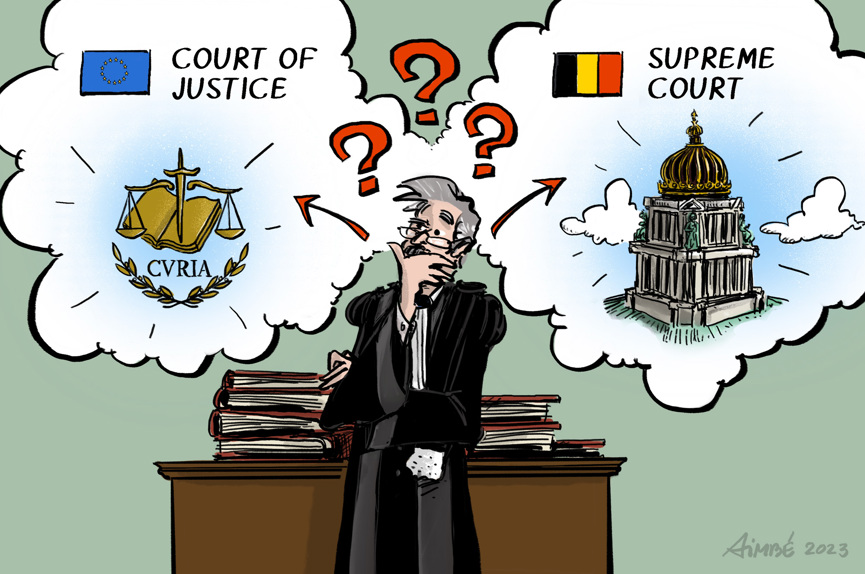- Administrative Law and Public Procurement
- Constitutional Court , Court of Justice , Supreme Court , Court of Justice of the European Union , hierarchy of norms , hierarchy of norms in the European Union , article 435, paragraph 2, of the Code of Criminal Procedure , law firm in Belgium , law firm in Brussels
Pursuant to the Constitutional Court's ruling of 1 December 2022, a court to which the Supreme Court refers a case for assessment on the merits is no longer bound by its cassation ruling with regard to the point of law decided, if that cassation ruling conflicts with a Court of Justice ruling handed down after the Supreme Court ruled on the case.
The Constitutional Court is thus responding to a preliminary question regarding article 435, paragraph 2, of the Code of Criminal Procedure, which stipulates that the court to which the Supreme Court refers the case again must comply with the judgment of the Supreme Court regarding the point of law decided by that Court.

1. What preceded (in a nutshell)
A person receives a new Belgian driving licence on 14 December 2012 after reporting the loss of his previous licence. The person moves to the Netherlands where, on 18 June 2015, he exchanges his Begian driving licence for a Dutch one.
However, the Dutch competent authorities found that the Belgian driving licence this person handed in to the Netherlands had the same number as the one he had reported as lost on 14 December 2012.
On 28 October 2016, the police court of West Flanders, Bruges division, sentenced that person to the penalty of forfeiture of the right to drive motor vehicles for a period of three months. The person was only able to be restored to his right after passing exams and undergoing medical and psychological tests.
The person appeals against this ruling of the police court to the court of first instance West Flanders, Bruges division, which on 30 June 2017 upheld the ruling of the police court of 28 October 2016.
That judgment of 30 June 2017 is appealed to the Supreme Court, which annuls it with its judgment of 11 September 2018. The Supreme Court held that the court of first instance West Flanders had given an incompatible interpretation of the applicable Belgian law. That interpretation would not be compatible with Directive 2006/126/EC on driving licences, as interpreted by the Court of Justice in a judgment of 26 April 2012.
2. Why the court felt compelled to refer a preliminary question to the Constitutional Court
The Supreme Court referred the case to the court of first instance East Flanders, Ghent division, for review on the merits.
The judge in Ghent found that the judgment of the Supreme Court might be in conflict with a judgment that the Court of Justice had meanwhile delivered on 28 October 2020, i.e. after the Supreme Court had delivered its judgment.
The judge in Ghent faced a problematic choice. On the one hand, in accordance with article 435, paragraph 2, of the Code of Criminal Procedure, he is obliged to comply with the judgment of the Supreme Court as far as the settled point of law is concerned. On the other hand, European law takes precedence over national law, and - in case of conflicting rulings - he must give precedence to the case law of the Court of Justice.
The court in Ghent therefore turned to the Constitutional Court with a preliminary question. After all, he was faced with two conflicting obligations.
3. Which preliminary question did the court put to the Constitutional Court?
The court in Ghent put two preliminary questions to the Constitutional Court, the first of which interests us here.
His question is whether the aforementioned provision of the Code of Criminal Procedure violates the principle of equality and non-discrimination (arts. 10 and 11 of the Constitution) and the right of access to the courts (art. 13 of the Constitution), read together with the right to a fair proceeding (art. 1 European Convention on Human Rights), to the extent that a court on referral must respect the Court's judgment and cannot include recent evolutions in the case law of authoritative courts such as the Constitutional Court and the Court of Justice in its ruling, while any other court hearing an identical case, which has not come before the Supreme Court, is not bound by that Supreme Court case law.
4. The ruling of the Constitutional Court
The Constitutional Court ruled on 1 December 2022 that the aforementioned Article 453(2) of the Code of Criminal Procedure, by providing that the court to which the Supreme Court refers a case must comply with the judgment of that court as regards the point of law decided, is not reconcilable with the principles of equality and non-discrimination (arts. 10 and 11 Gw.) and the right of access to justice (art. 13 Cw.), read together with the right to fair proceedings (art. 6.1 ECHR), to the extent that it would prevent a litigant from relying on case law of the Court of Justice of the European Union dating from after the judgment of the Supreme Court in defence of its rights and interests regarding that point of law.
The judgment which differs from the judgment of the Supreme Court should also be subject to a further appeal in cassation.
5. Considerations and conclusion
The court was not obliged to put this question to the Constitutional Court. After all, European law takes precedence, including European Court of Justice case law, over national law. That is the hierarchy of norms in the European Union (except for a few unruly member states).
Thus, the referring court had to give precedence to the Court of Justice's more recent judgment anyway, regardless of the provision of Article 435(2) of the Code of Criminal Procedure. Indeed, this flows from the hierarchy of norms itself. The question was therefore redundant.
The Constitutional Court could therefore also have ruled that the question did not need to be put, in view of the hierarchy of norms and the fact that the Supreme Court had already stated in its famous Smeerkaas judgment of 27 May 1971 that treaties with direct effect take precedence over national laws, including the Constitution.
As a result of the Constitutional Court judgment discussed here, the legislature will therefore not have to amend Article 435(2) of the Code of Criminal Procedure. It is sufficient to honour the hierarchy of norms.
The Judicial Code contains a similar provision to article 435, paragraph 2, Code of Criminal Procedure, namely article 1110, paragraph 4, Judicial Code. Even then, the hierarchy of norms applies, and precedence must be given to the more recent case law of the Court of Justice. Therefore, the Constitutional Court's judgment of 1 December 2022 also applies mutatis mutandis to Article 1110(4) Judicial Code.
Should you have any questions on this subject, please do not hesitate to contact our specialists at info@seeds.law or +32 (0)2 747 40 07.




